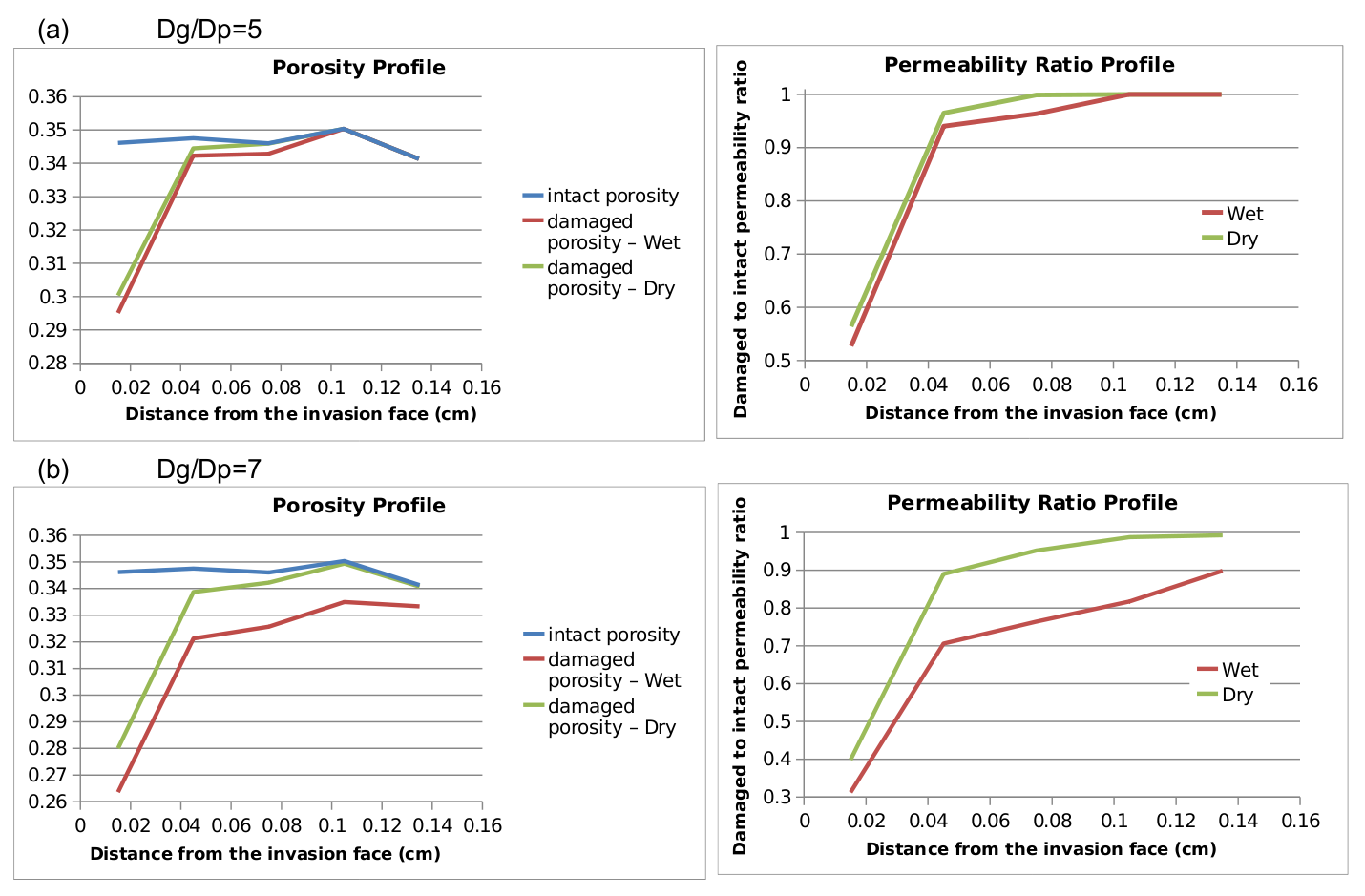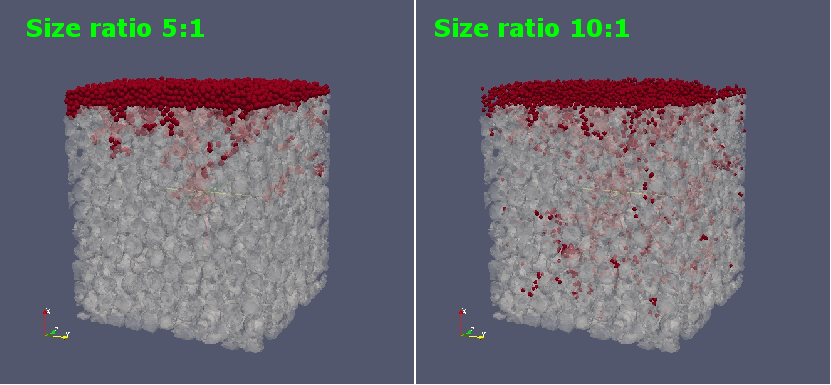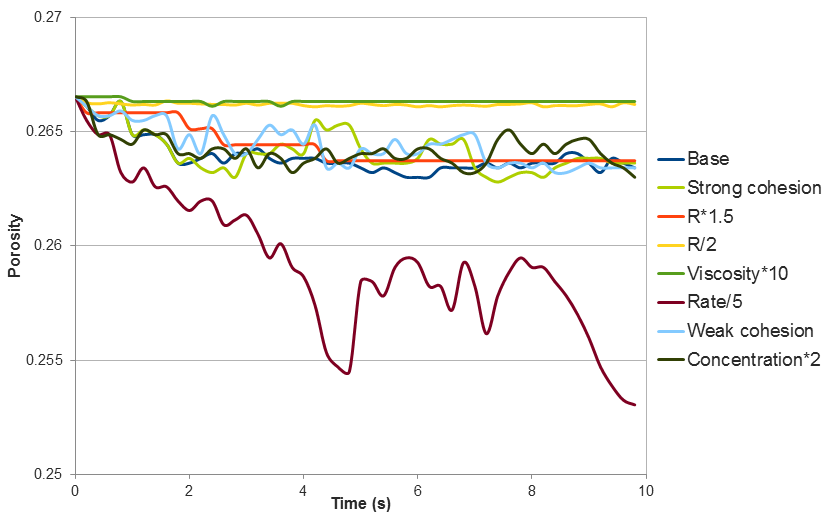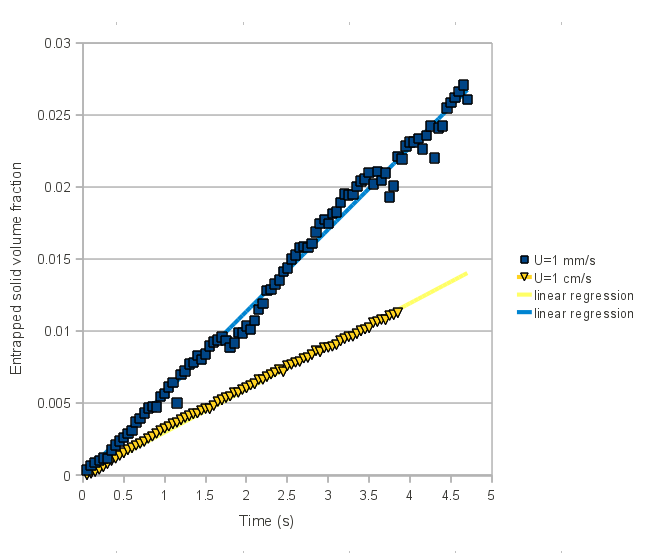58th Annual Report on Research 2013 Under Sponsorship of the ACS Petroleum Research Fund
Reports: DNI952340-DNI9: Coupled Fluid and Solid Mechanics Study for Improved Permeability Estimation of Damaged Formations Near Wellbore
Masa Prodanovic, PhD, University of Texas (Austin)
Formation damage at the near wellbore region is mainly caused by infiltration of suspensions circulating in the wellbore (e.g. drilling mud) or injected into the formation (e.g. waste water). Suspended particles which get entrapped in the damaged zone significantly reduce the permeability of the near wellbore region and consequently impair the productivity of the reservoir or the injectivity of the injection wells. For instance, under laminar flow conditions, particles as small of 7% of the median pore throat size have the ability to plug the pores, but that is not valid for turbulent flow. Therefore understanding the mechanisms of formation damage and the factors controlling its severity is vital for predicting the well performance and improving the efficiency of production and injection operations.
Simulation of filtration proved useful in modeling permeability damage, however, the models usually require rigorous parameter matching before becoming predictive. We propose a pore-scale modeling of filtration with minimum parameter tuning to gain a thorough understanding of the underlying physics.
2 Summary of Results
We adopt a semi-coupled fluid and particulate flow modeling approach to directly model suspension flow through a porous medium. The flow domain was extracted both from model sphere packs and imaged sandstones. MATLAB, CGAL and Gmsh software packages were used to discretize flow domains for further flow field computations.
2.1. Dry vs. Wet simulation models
Discrete element method has been used by a number of authors to study the filtration of suspensions with larger particles. Since DEM does not directly model fluid flow, the presence of the host fluid can be modeled indirectly by adding a drag force to the DEM formulation.We use the Stokes hydrodynamic drag formula with a constant fluid velocity term (not changing in space and time). We call this the "dry" model.
Fluid flow can be directly modeled by a coupled CFD-DEM approach, which we call the "wet" model. Here the drag on the particles varies with time and location, however the computation is more resource-intensive. The comparison of the permeability and porosity profiles of the invaded sample for both models is available in Fig. 1 and Fig. 2.
Figure 1: Snapshots of the Finney sphere pack infiltrated by suspensions with particles of diameters 1/5th (left) and 1/10th (right) of the grain diameter.

Figure 2: Porosity and permeability profiles resulting form wet and dry models of infiltration of suspensions with particles (a) 5 times smaller and (b) 7 times smaller than the grains. Permeability ratio is calculated based on Carman-Kozeny equation.
As the particle size decreases, depth of penetration increases and the difference between wet and dry models grows larger. Simulations in a Fontainebleau sandstone microtomography images also confirmed this trend. Hence, "wet" model is far more accurate.
2.2. Flow through a single pore
We studied the effects of various flow properties on particle capturing in a single pore. Two different pore geometries were used: a single pore extracted form random mono-sized sphere pack and a single pore extracted from a Berea sandstone image. The results suggest that the most influential factor in particle entrapment in a single pore is the flow rate. For suspension flow through a sphere pack pore (Fig. 3), higher rates cause less particle entrapment and this might be due to larger drag forces at higher flow velocities. However, sensitivity analysis showed an increase in pore plugging at higher flow rates for the single Berea pore (Fig. 4).
Figure 3: Change in the porosity of a single sphere pack pore as suspensions with various properties flow through it.

Figure 4: Effect of the fluid velocity on a single Berea pore plugging. Sudden drop in porosity indicates jamming.
Fluid velocity controls two competing effects: 1) sweeping away of particles by the hydrodynamic drag force and 2) jamming of particles at the pore throats. Larger velocities enhance both effects. For bigger pore to particle size ratio, where jamming is less likely to occur, increasing flow rate decreases particle capture probability whereas for smaller pore to particle size ratio, jamming effect dominates and is more frequent at high flow rates.
2.3. Entrapment kinetics
Rate of entrapment T is the rate of exchange of particles between rock and fluid phases and is considered a phenomenological parameter. The majority of proposed correlations estimating the rate of entrapment for deep bed filtration models assumes a first order dependency on the total volumetric particle flow rate in the form T=LUc where U is fluid velocity and c is the suspension concentration. Parameter L is called the "filtration coefficient" and is often assumed to be either constant or a function of the entrapped solid volume fraction.
We hypothesize that the rate of entrapment is a higher order function of the flow velocity, as opposed to the common belief. We tested this hypothesis by simulating the flow of two different suspensions through the Finney pack (Fig. 1) and keeping Uc=constant (see results in Fig. 5).
Figure 5: Entrapped solid volume fraction increases linearly with time; but is a function of U and not constant with constant Uc (viscosity 1 cp, particle to grain size ratio is 1/7).
It is clear that the rate of entrapment remains constant even after the injection of 20 pore volumes of suspension and does not show a strong dependency on the trapped solid volume fraction for fractions as low as 1-2%. In addition, rate of entrapment changes with velocity despite the constant total particle flow rate Uc.
3 Impact
The graduate student Maryam Mirabolghasemi enjoyed full research and tuition support from ACS-PRF in 2012/13 academic year. The project approach is novel, and requires intensive use of parallel resources (available through Texas Advanced Computing Center). Despite no prior experience, Maryam made a great progress. She presented a poster at AGU Fall meeting in December 2012. Journal publication is in preparation.
Copyright © 2014 American Chemical Society














